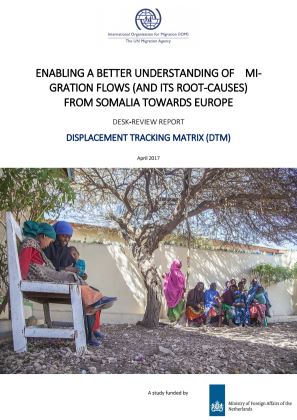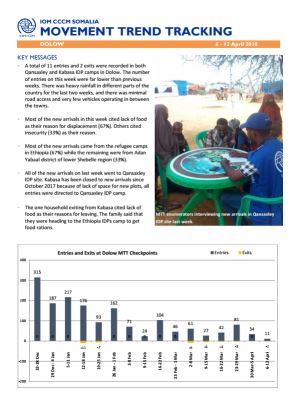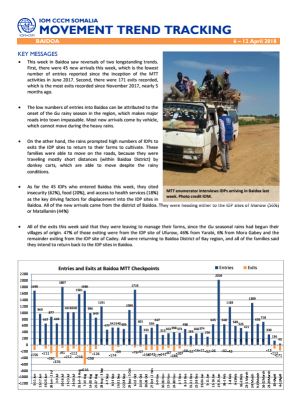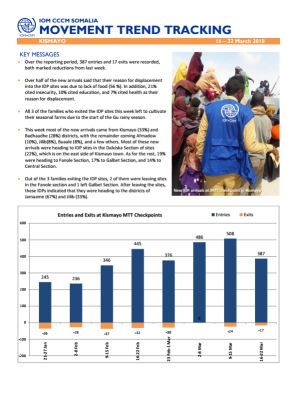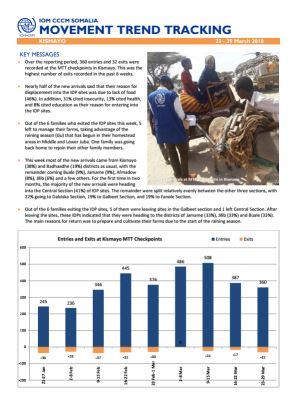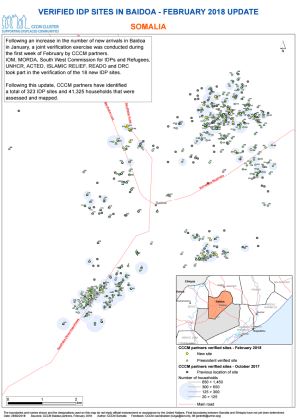-
Countries
-
Data and Analysis
-
Special Focus
-
Crisis Responses
Somalia
Somalia
Desplazados internos rastreados
Movimientos de desplazamiento
3,862,000
IDMC 2023
Ronda de recopilación de datos
Sobre Somalia
IOM Somalia Displacement Tracking Matrix (DTM) aims to collect, analysis and disseminate information on displacement. DTM is IOM’s information management system to track and monitor numbers, locations, movements, needs and vulnerabilities of displaced people. The data outputs, including reports, maps, datasets and online interactive resources, support responses in humanitarian crisis, evidence-based decision making, durable solutions programming and migration research. DTM Somalia was first launch in 2016.
Since the collapse of the Somali central government in 1991, Somalia has suffered a highly complex protracted conflict characterized by changing political dynamics and power shifts. Forced displacement remains an ongoing reality for people living in Somalia due to conflict, environmental hardships, combined with inadequate resource distribution that is often exacerbated by clan-based, ideological differences and land and natural resource competition. Natural hazards, including drought and flooding, combined with widespread security threats have caused one of the world’s largest displacement crises, with 3.8 million IDPs recorded at the end of 2022. Somalia also has a strategic geographical position on the eastern route, which connects the Horn of Africa to the Gulf countries, representing one of the most dangerous and frequented migration corridors in the world.
Current Donors
- EU
- ECHO
- BHA
- Canada
- JSB
- World Bank
Para obtener resultados de búsqueda más avanzados, vaya a la Página de búsqueda avanzada de informes
Somalia — Dolow Movement Trend Tracking Report (20—26 April 2018)
This week a total of 2 entries and 11 exits were recorded in Qansaxley IDP camp. The 11 people leaving the sites represent the highest number of exits recorded in a single week since mid-January.
Somalia — Baidoa Movement Trend Tracking Report (27 April —3 May 2018)
Due to inter-clan clashes that erupted in the outskirts of Baidoa, mainly triggered by conflicts between clans for grazing land, a total of 56 indivudals fled for safety into the Biadoa IDP sites. All stated that their reason for entry was insecurity.
Somalia — Baidoa Movement Trend Tracking Report (20—26 April 2018)
For the fourth week in a row, the number of people exiting the IDP sites increased, this week reaching 295 - the most recorded in a single week since August 2017. In contrast, the number of new entries dropped this week from 92 last week to 60 this week.
Somalia — Border Point Flow Monitoring (October—December 2017)
The flow monitoring Population Movement Tracking assessments are conducted through household surveys atkey border crossing locations between Somalia and neighbouring countries.
Somalia — Enabling a Better Understanding of Migration Flows (And its Root Causes) from Somalia Towards Europe — Desk-Review Report (April 2017)
This desk review report is part of the outputs of the first phase of IOM’s project implementation on data collection to enable a better understanding of migration flows from Afghanistan, Ethiopia, Iraq, Nigeria, Pakistan and Somalia towards Europe.
Somalia — Kismayo Movement Trend Tracking Report (13—19 April 2018)
Over the reporting period, a slightly lower number of 218 entries were recorded compared to last week, and 44 exits were recorded – the highest number of exits since MTT started recording data 11 weeks ago.
Somalia — Kismayo Movement Trend Tracking Report (6—12 April 2018)
Over the reporting period, a slightly higher number of total of 317 entries were recorded compared to last week, but fitting within the general range seen over the past 10 weeks. No IDPs were recorded exiting any of the camps this past week.
Somalia — Dolow Movement Trend Tracking Report (13—19 April 2018)
This week a total of 13 entries and 10 exits were recorded in both Qansaxley and Kabasa IDP camps. The 10 people leaving the sites represent the highest number of exits recorded in a single week since mid-January.
Somalia — Dolow Movement Trend Tracking Report (6—12 April 2018)
A total of 11 entries and 2 exits were recorded in both Qansaxley and Kabasa IDP camps in Dolow. The number of entries on this week were far lower than previous weeks.
Somalia — Baidoa Movement Trend Tracking Report (13—19 April 2018)
This week in Baidoa there were 92 new arrivals who reported in the three main check points of the town. This shows an increase as compared with last week’s data which was 45 new arrivals. Nonetheless, the last two weeks' new arrivals are far less than the trends seen in previous months.
Somalia — Baidoa Movement Trend Tracking Report (6—12 April 2018)
This week saw reversals of two longstanding trends. 45 IDPs were recorded arriving in Baidoa this week, which is the lowest number of entries reported since the inception of the MTT activities in June 2017.
Somalia — Kismayo Movement Trend Tracking Report (16—22 March 2018)
Over the reporting period, 387 entries and 17 exits were recorded at Kismayo check points, both marked reductions from the previous week.
Somalia — Kismayo Movement Trend Tracking Report (30 March — 5 April 2018)
Over the reporting period, 289 entries and 21 exits were recorded at Kismayo check points.
Somalia — Dolow Movement Trend Tracking Report (30 March — 5 April 2018)
This week, 34 new arrivals and zero exits were recorded at Dolow check points. The number of arrivals reported this week was less than half the number recorded last week.
Somalia — Baidoa Movement Trend Tracking Report (30 March — 5 April 2018)
This week witnessed significantly reduced numbers of new arrivals and a spike in exits. 136 IDPs were recorded arriving in Baidoa this week, the fewest number of new arrivals ever recorded in one week.
Somalia — Kismayo Movement Trend Tracking Report (23—29 March 2018)
Over the reporting period, 360 entries and 32 exits were recorded at the MTT checkpoints in Kismayo. This was the highest number of exits recorded in the past six weeks.
Somalia — Dolow Movement Trend Tracking Report (23—29 March 2018)
During the forth week of March, a total of 81 entries and 3 exits were recorded at Kabasa and Qansaxley camps in Dolow. The number of entries during this week were twice as high compared to the previous week were 42 entries were observed.
Somalia — Baidoa Movement Trend Tracking Report (23—29 March 2018)
This week there were only 330 new arrivals through the Baidoa checkpoints, the fewest number recorded by MTT since Mid-January.
Somalia — Dolow Movement Trend Tracking Report (16—22 March 2018)
In the third week of March, a total of 42 entries and 4 exits were recorded at Kabasa and Qansaxley camps in Dolow. This week, entries are much higher than last week (27 entries). Most of the new arrivals this week cited lack of food as their reason for displacement (89%).
Somalia — Baidoa Movement Trend Tracking Report (16—22 March 2018)
This week, 718 new arrivals zero exits were recorded at Baidoa check points. This is the sixth week in a row with no exit. The number of arrivals reported this week was higher than the number recorded last week.
Somalia — Humanitarian Response Annual Report (2017)
Somalia continued to face drought conditions in 2017 due to four consecutive rainy seasons.
Somalia — Monthly Update 1 (January 2018)
While the risk of famine in Somalia has declined, humanitarian needs remain at critical levels. An estimated 5.4 million people are in need of assistance, 2.1 million are internally displaced, and 1.2 million children are projected to be malnourished.
Mar 02 2018
Somalia — Monthly Update 1 (January 2018)
Somalia — Verified IDP sites in Baidoa (February 2018)
Following an increase in the number of new arrivals in Baidoa in January, a joint verification exercise was conducted during the first week of February by CCCM partners.
Somalia — CCCM Cluster Dashboard (January 2018)
This dashboard provides a summary of CCCM activities, cluster partners presence, beneficiaries reached, and site assessments. 1.1 million people have been identified as newly displaced since January 2017. 1,751 sites werre assessed in 24 districs and 1,549,830 individuals were reached.
Mar 02 2018
Somalia — CCCM Cluster Dashboard (January 2018)
Pagination
Para obtener resultados de búsqueda más avanzados, vaya a la Página de búsqueda avanzada de conjuntos de datos






